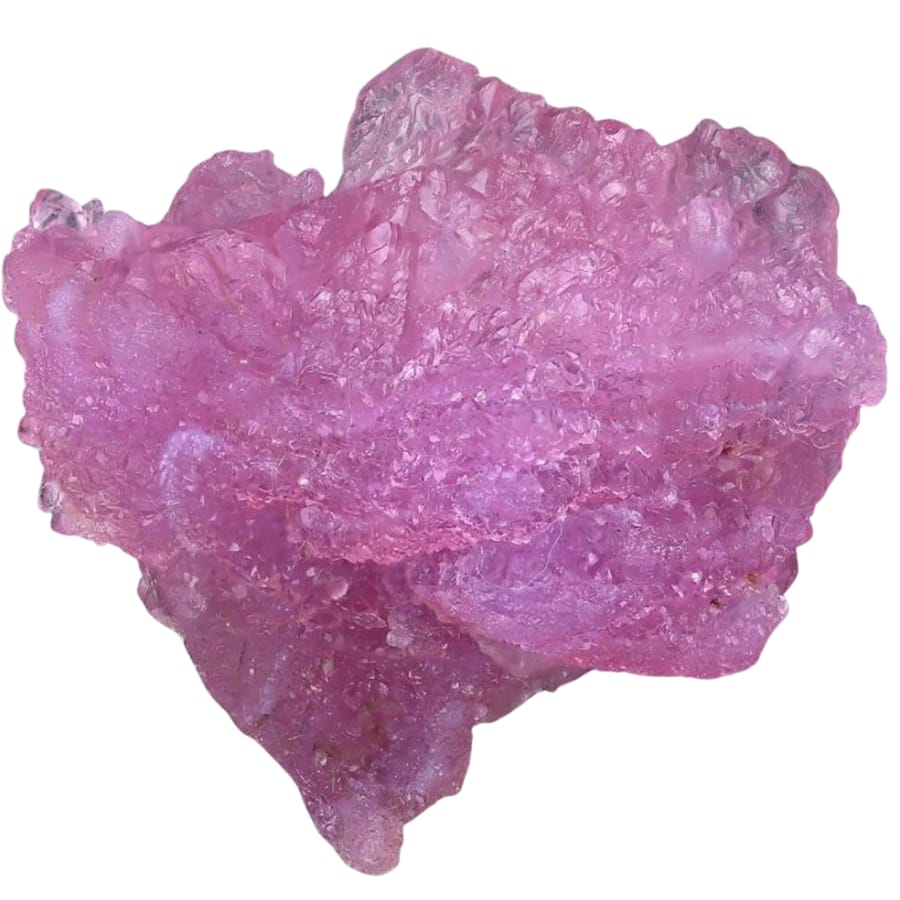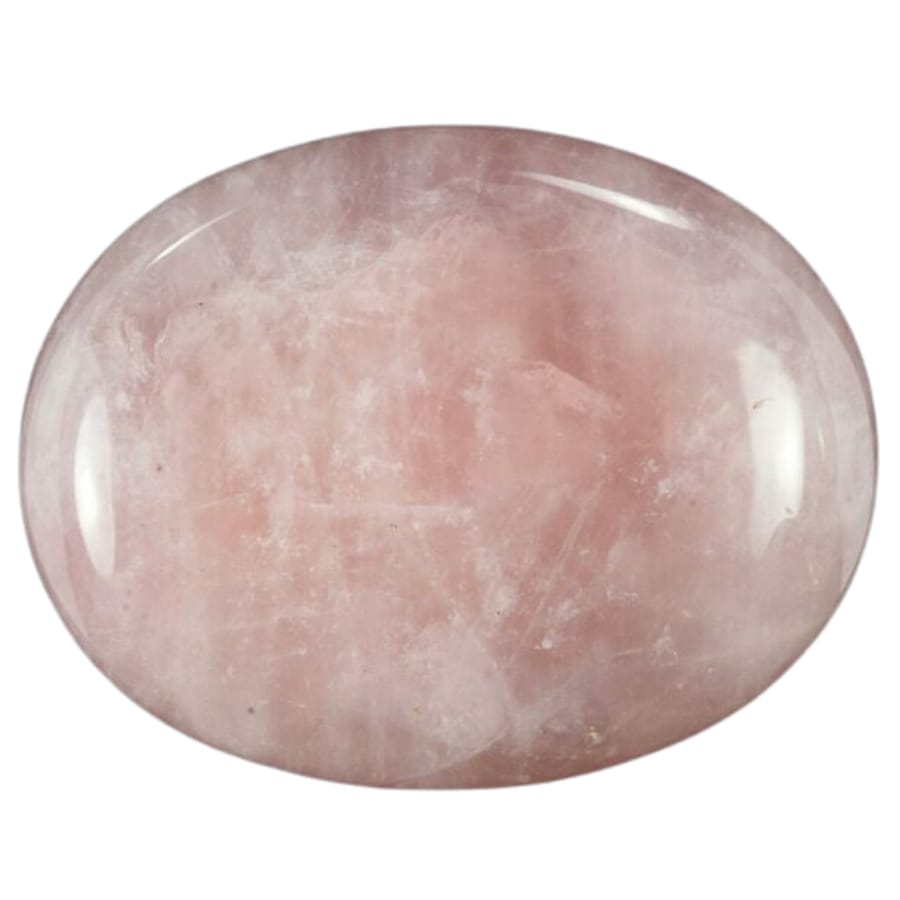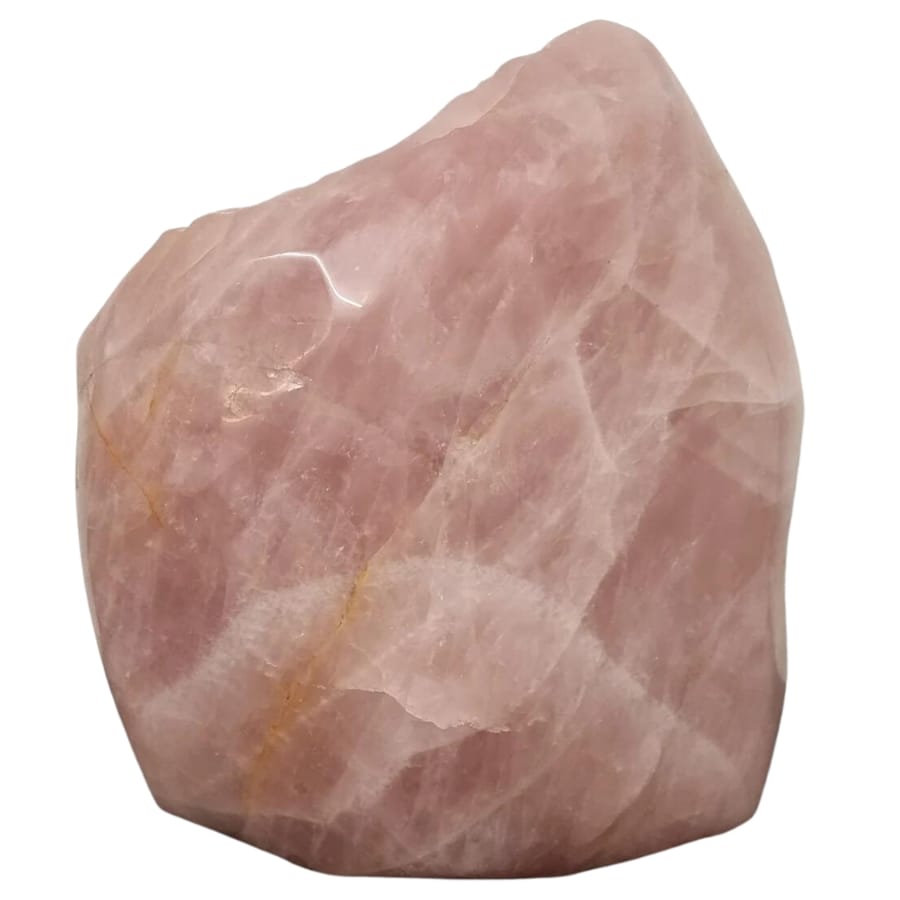Pink calcite and rose quartz are two beautiful minerals that gem lovers and people looking at them often find themselves drawn to. These stones are known for having beautiful pink colors, making them popular for jewelry and home decor.
Despite some similarities, these two minerals are very different. Our article explains what makes each one unique and displays where they overlap and separate.
After reading this article, discovering the properties of pink calcite and rose quartz will teach and amuse you whether you want to become a geologist or enjoy nature’s beauty!
Pink Calcite vs. Rose Quartz – The Major Differences
Pink calcite and rose quartz are very pretty, but some big differences will help you tell them apart. These things set them apart:
Appearance – Rose quartz rarely form visible crystals

Several important things help you tell the difference between pink calcite and rose quartz just by looking at them. Pink calcite is often see-through to partially see-through, meaning light can pass through it.
This can make it look bright, almost glowing. This mineral usually forms crystals with clear shapes. Its rhombohedral or scalenohedral shapes make it easy to spot.
Pink calcite is beautiful because these crystal shapes can sometimes have a shiny, glass-like surface.
On the other hand, rose quartz usually looks less clear and more uniform. It doesn’t usually form clear crystals; instead, it forms large, granular masses that don’t have the well-defined crystal shapes that pink calcite does.
This makes rose quartz look softer, smoother, and sometimes almost milky. It is a soft pastel pink color all the way through, unlike pink calcite, which can have color changes and zones.
Even though both minerals are pink and look pretty, they are very different when you look more closely. They are not the same regarding how clear they are, how crystals form, or how consistent the color is.
Chemical Composition – Pink calcite is a form of calcium carbonate

Two beautiful pink minerals, pink calcite and rose quartz, have very different chemical makeups.
Pink calcite is mostly made up of calcium carbonate (CaCO₃). The mineral belongs to the larger group of carbonate minerals, which are defined by the presence of the carbonate ion (CO₃)²⁻.
While pink calcite is usually pink because of impurities or inclusions in its structure, these can be trace elements like iron or manganese.
Rose quartz is a type of quartz that contains silicon dioxide (SiO₂). This mineral belongs to the silicate group, which is defined by the presence of silicon and oxygen.
Small amounts of iron, manganese, or titanium usually cause the unique pink color of rose quartz.
Microparticles of a different mineral called dumortierite may sometimes also add to the color.
Their basic chemical makeup is different, which makes them different from each other and affects many of their physical properties and formation environments.
Cleavage – Rose quartz has no cleavage

The way a mineral breaks along specific weak planes is called cleavage, and there is a big difference between pink calcite and rose quartz. People know that pink calcite can perfectly split in three directions, creating rhombohedral pieces.
This clear cleavage is so useful that it’s often used to help doctors figure out what kind of calcite something is. When pink calcite is broken, it always leaves behind smooth, flat surfaces that show how it’s structured inside.
Rose quartz does not show cleavage, and neither do other quartz minerals. It instead breaks along irregular, conchoidal cracks. Rose quartz has curved surfaces that look like the ridges outside a seashell when broken.
The strong covalent bonds in its silicon dioxide crystal lattice keep it from breaking along defined planes, so it doesn’t cleave.
So, the cleavage differences between pink calcite and rose quartz are not unique, but they also come from how their molecules are built.
Density – Pink calcite has a higher density

The density of a mineral, or how much mass it has per unit volume, changes depending on what chemicals are in it and how it is structured inside.
Because their chemicals are different, pink calcite and rose quartz have different densities. Calcium carbonate (CaCO₀), which is what pink calcite is made of, has a relatively lower density, usually around 2.71 g/cm³.
This lower density is because of the minerals’ relatively lighter parts, like calcium and carbon, and how their crystal structure makes them.
But rose quartz is a type of quartz that is made up of silicon dioxide (SiO₂). This substance is a little denser, usually around 2.65 g/cm³.
This small difference is caused by the heavier silicon atoms and the way the atoms are arranged in the quartz crystal lattice.
This difference in density may not seem like a big deal. Still, it can be very important, especially when working with larger samples or in industrial settings where material weight is very important.
Formation – Rose quartz forms in igneous rocks

Even though both pink calcite and rose quartz are very pretty, they form in very different geological settings.
Calcite that is pink usually forms in sedimentary settings, where it can settle from calcium-rich water in shallow marine environments, such as lagoons.
It can also be found in rocks that have changed over time and in hydrothermal veins, where hot fluids that are rich in minerals deposit the mineral as they cool.
The presence of pink calcite can also be a sign of a place in the past where heat and pressure changed the original composition of limestone or dolomite.
Rose quartz mostly forms in igneous environments. It’s often found in pegmatites, which are coarse-grained igneous rocks that formed at the very end of magma crystallization.
The slow cooling of these magmas makes it possible for big, well-formed crystals like rose quartz to form. Also, like pink calcite, rose quartz can sometimes be found in hydrothermal veins, but this doesn’t happen very often.
The fact that these two minerals formed through very different geological processes shows how varied and changing Earth’s geology is.
Fluorescence – Pink calcite can display fluorescence

When a mineral is exposed to ultraviolet light, it gives off visible light. Pink calcite and rose quartz are very different in how they fluoresce.
Fluorescence is something that pink calcite is known for, which makes it more appealing to collectors and enthusiasts. It is common for pink calcite to glow reddish or pink under UV light.
However, the exact color can change depending on the impurities or activator ions that are in the crystal structure. In this case, the fluorescence comes from trace elements like manganese or organic compounds mixed in with the calcite as it forms.
Rose quartz doesn’t usually fluoresce. Quartz can fluoresce sometimes, but rose quartz rarely has this property.
The main chemical that makes it up is silicon dioxide (SiO₂), but it lacks the activators that would make it fluoresce when exposed to UV light.
Because of this, rose quartz usually doesn’t react with ultraviolet light; it keeps its normal look and doesn’t give off any noticeable light. This clear difference in how they fluoresce adds another layer of differentiation between these beautiful pink minerals.
Hardness – Rose quartz is harder

One important way to tell the difference between pink calcite and rose quartz is by their hardness, measured on the Mohs scale. Pink calcite is only about 3 on the Mohs scale, which is not very hard.
You can easily scratch pink calcite with a copper penny or even your fingernail because it’s so soft. Calcite isn’t as hard because of the way its molecules are structured.
Weaker ionic bonds, which don’t shield against scratches or stronger bonds, hold the calcium carbonate molecules together.
Rose quartz, on the other hand, is much harder, with a Mohs hardness of 7. This hardness is typical for quartz, meaning that rose quartz can scratch common things like glass and even some metals.
Its chemical make-up is what gives it this higher hardness. Rose quartz comprises silicon dioxide (SiO₂), which comprises four oxygen atoms bonded together in a strong network.
Because of how its crystals are arranged, rose quartz is much harder to scratch than pink calcite.
The difference in hardness between pink calcite and rose quartz makes them two different minerals. It also affects how they are used and how long they last in jewelry and other decorative items.
Price – Pink calcite are more expensive

Minerals like pink calcite and rose quartz can have different prices depending on how rare they are, how much people want them, how good they are, and how big they are.
The value of pink calcite is generally more affordable than rose quartz. This is partly because it’s pretty common and easy to get. It’s a common mineral that can be found in large deposits.
It comes in many different forms. Even though the pink variety is less common than the clear or white ones, it’s still pretty easy to find. Due to its ease of access and the fact that it’s softer, making it less durable for uses like jewelry, it tends to keep its price low.
Rose quartz are often more valuable. Even though rose quartz isn’t a very uncommon mineral, it can be harder to find high-quality specimens, especially ones with a deep, even color and few inclusions.
It costs more because of this and the fact that it’s harder, which makes it better for a wider range of jewelry and decoration uses. In recent years, rose quartz has become very popular.
Rose Quartz vs. Pink Calcite – The Similarities
Pink calcite and rose quartz are not the same, but there are some interesting ways in which they are alike. If someone only knows these gems by how they look, these things about them might surprise them.
Color – Both rose quartz and pink calcite are pink

The most noticeable and appealing thing about pink calcite and rose quartz is that they are both pink.
Both minerals come in different shades of pink, from very light pinks that look like pastels to brighter, deeper pinks. People often first compare the two based on the colors they use together.
The pink in both minerals has a softness and warmth that can make you feel calm and peaceful. They both have the color pink, which is appealing in decorative settings.
Even though these two minerals have different chemical make-ups and structures, it’s interesting that nature can give them such similar color patterns.
Most of the time, the pink color in pink calcite comes from impurities or inclusions, like iron or manganese traces. The pink color of rose quartz is usually caused by small amounts of titanium, iron, manganese, or another mineral called dumortierite mixed in.
The color similarity between pink calcite and rose quartz is an interesting example of how different geological processes can produce similar results.
Conductivity – Neither pink calcite nor rose quartz can conduct electricity

One important thing that pink calcite and rose quartz have in common is that they are neither very good at conducting electricity. This is a trait that most minerals have when they are pure.
Pink calcite is mostly made up of calcium carbonate (CaCO₀), but its molecular structure doesn’t let electrons move freely, which is needed to conduct electricity.
In the same way, rose quartz, which is mostly silicon dioxide (SiO₂), doesn’t have the right internal structure to conduct electricity well either.
Both minerals don’t conduct electricity well because of how their atoms are bonded together. Calcite and quartz both have structures where electrons can’t move around freely because of their ionic and covalent bonds.
Because of this, both pink calcite and rose quartz don’t conduct electricity; they block it. Even though they are made of different chemicals and formed in different ways, they behave similarly in terms of electrical conductivity, which is an interesting point where they overlap.
This shared property also affects their use in different situations; they are often chosen when electrical insulation is needed.
Location – Rose quartz and pink calcite can be found globally

There are many places around the world where you can find pink calcite and rose quartz. You can find both these gemstones in these great rockhounding locations.
Both pink calcite and rose quartz can be found in similar geological settings, even though they are formed in different ways and have different chemical makeups. These two minerals are pretty common and can be found in many places worldwide.
Some countries that have large amounts of pink calcite are Mexico, the United States, and several European countries. The same is true for rose quartz, which comes from many places, such as Brazil, Madagascar, the US, and India.
Sometimes, you can find both minerals in the same country or geologically similar places. This geographical overlap is an exciting similarity because they have different mineralogy.
It shows how different mineral-rich areas are and the complicated geological processes that make it possible for so many minerals to be found close to each other.
Luster- Pink calcite and rose quartz both have a vitreous luster

Pink calcite and rose quartz are very different from each other, but they both shine. Luster is the way the surface of a mineral reacts with light, and both minerals have a lot of it.
When first cut or polished, pink calcite and rose quartz usually have a vitreous, or glass-like, shine. This vitreous luster makes their surface shiny and reflective, which adds to their beauty.
Considering that they have different chemical makes-ups and crystal structures, the fact that they have a similar sheen is very interesting. The shiny look of pink calcite comes from the calcium carbonate composition and crystal form.
In the same way, rose quartz has a vitreous luster because of its structure of silicon dioxide and its crystalline form.
The fact that both minerals have a shiny surface is one reason why they are valued in jewelry and decorative arts: the shiny surfaces catch the light and make the minerals look more beautiful.
Magnetic – Both rose quartz and pink calcite are not magnetic

Regarding magnetism, pink calcite and rose quartz are a lot alike: they are both usually not magnetic. In everyday situations, this means they don’t have magnetic properties and aren’t drawn to magnets.
Both minerals are not magnetic because of how they are chemically structured and the elements they contain.
Pink calcite is mostly made up of calcium carbonate (CaCO₀), and no elements in its structure would have magnetic properties.
In the same way, rose quartz, which is mostly silicon dioxide (SiO₂), doesn’t have any magnetic properties of its own. Because they don’t contain pure elements like iron that could give them magnetic properties, magnetic fields don’t affect pink calcite or rose quartz.
One thing that these two otherwise different minerals have in common is that they are not magnetic. This feature can help identify minerals and is also important in many situations where non-magnetic materials are sought after.
Streak – Pink calcite and rose quartz have a white streak

While pink calcite and rose quartz have different looks and properties, they have the same color streak. You can tell what kind of mineral it is by its streak, which is the color of its powdered form.
No matter what color the mineral is on the outside, the streak color of pink calcite and rose quartz is usually white or colorless.
This similarity in streak is pretty interesting since they are made up of different things and are different colors.
The white streak in pink calcite comes from the calcium carbonate, which loses its pink color when it’s ground up.
In the same way, rose quartz has a pink color, but when it is rubbed against a streak plate, its silicon dioxide makes a white or colorless streak.
The fact that these two minerals have a white or colorless streak shows that minerals can be more complicated than they seem.
Streak testing can show this hidden similarity, showing that these pink minerals, which are normally very different, share a trait.
The Easiest Ways To Tell Pink Calcite and Rose Quartz Apart

If you want to buy a pink calcite or rose quartz, it’s helpful to know the difference between them. There are several ways to tell which is which.
Feel the surface
Pink calcite is softer than rose quartz. Imagine using a copper penny to scratch a mineral. If it leaves a mark, it’s probably pink calcite.
Rose quartz is harder, so it won’t scratch as easily. You can even try scratching glass with rose quartz; it’s likely to leave a scratch because it’s pretty tough!
Check the appearance
Pink calcite often has a unique look; it can be clear or have cool patterns inside, like stripes or zigzags.
Rose quartz is usually cloudy or foggy looking, and you don’t usually see those patterns in it. Also, pink calcite can have different shapes with flat faces and sharp edges, while rose quartz usually doesn’t have well-defined faces.
Observe the shine
When you polish them up, both can look shiny like glass, but pink calcite has an extra special kind of shine. It’s like it has a light inside it. Rose quartz has a more gentle and smooth shine.


